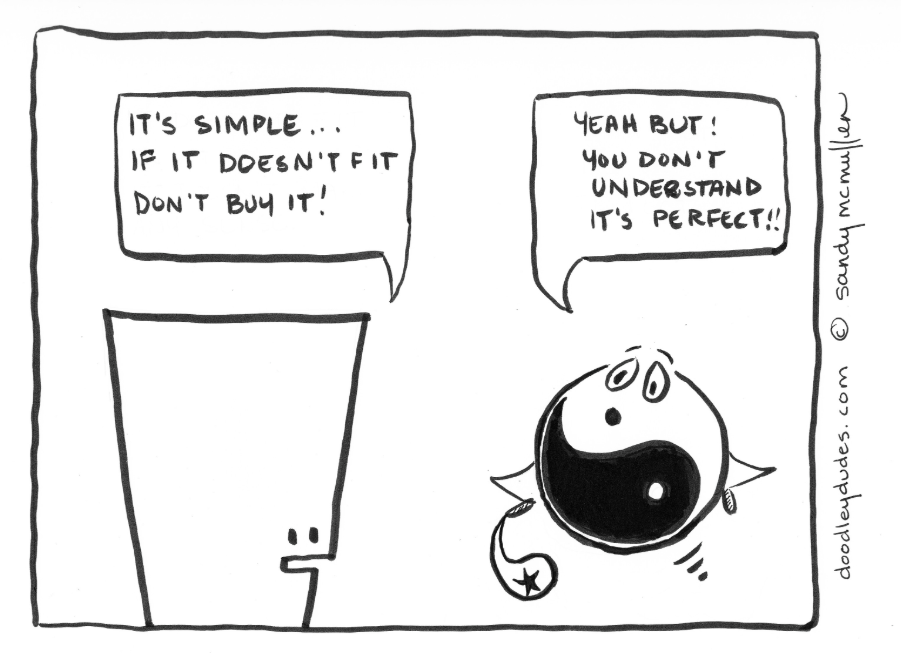
by Sandy | Jul 24, 2018 | MBTI Facts
The Theory
The Thinking preference makes decisions objectively based on matching to rational, logical criteria.
The Feeling preference has a decision-making process that is subjective and is based on values and how the decision will affect the people involved. It is a rational process – the criteria are different.
So that’s the theory.
The Reality
This difference can be the cause of a lot of misunderstanding in relationships. I love this cartoon because from a Thinking perspective this purchase makes no sense, but how many people have had this very moment in their shopping experience. This cartoon is at the expense of the Feeling preference so I’d like to point out the value Feeling makes in contributing to harmony and well-being. Better decisions are made when both Thinking and Feeling are considered.
Disclaimer
BTW if the joke was on the other foot I wonder if Thinking types would react. They might be irritated, or they might not even notice. “It’s not personal.” could almost be a Thinking mantra.

by Sandy | Jul 21, 2018 | Best Practices, MBTI Facts
Psychometrics is the hub for MBTI training, certification and access to the MBTI inventory in Canada. They are the “go to” source for new information and resources. The January newsletter is an example of bringing new insights and applications to both MBTI practitioners and the business community alike. This article is copied with permission.
Dealing with Organizational Change
By Shawn Bakker Of Psychometrics
Nancy Barger and Linda Kirby have integrated type theory with William Bridges’ stages of transitions. They asked 2,000 workshop participants to respond to the following question, “What does each preference need during a time of change?” The responses provide some understanding of how people facing the same transition may have different needs.
Extraversion
Time to talk about what is going on
Involvement – they want something to do
Communication, communication, communication
To be heard – to have a voice
Action, getting on with it, keeping up the pace
Introversion
Time alone to reflect on what is happening
To be asked what they think
Thought-out, written communication and one-on-one discussion
Time to think things through before discussions and meetings
Time to assimilate change before taking action
Sensing
Real data – why is the change occurring?
Specifics about what exactly is to change
Connections between the changes and the past
Realistic pictures of the future that make plans real
Clear guidelines on expectations, roles, and responsibilities
Intuition
The overall rationale – the global realities
A general plan or direction to play around with and develop
Chances to paint a picture of the future – to create a vision
Options – a general direction, but not too much structure
Opportunities to participate in designing the future
Thinking
Clarity in the decision making and the planning
Demonstration that leadership is competent
Fairness and equitability in the changes
The logic – Why? What are the goals? What systemic changes will there be?
Feeling
Recognition of the impacts on people
Demonstration that leadership cares
Appreciation and support
Inclusion of themselves and others in the planning and implementing on change
Know how individuals’ needs will be dealt with
Judging
A clear, concise plan of action
Defined outcomes, clear goals
A clear statement of priorities
A time frame, with each stage spelled out
No more surprises!
Perceiving
An open-ended plan
The general parameters
Flexibility, with lots of options
Information and the opportunity to gather more
Loosen up, don’t panic, trust the process
Barger and Kirby provide much more information on how to deal with change in their book
The Challenge of Change in Organizations.

by Sandy | Jul 15, 2018 | Best Practices, MBTI Facts, Personal Expression
Imagine seventeen creative people in one confined 20 x 30 foot space for five days in a painting workshop exploring non-objective painting. Interestingly non-objective painting is a very personal and internal experience. My perspective on it is that you have to know who you are, know how to handle the materials and then surrender to the process – letting it flow through you. It is not for the timid or faint of heart.
Given that context, imagine the effect of people having animated (in other words LOUD) conversations about topics both trivial and profound on those engaged in this deeply challenging process and then consider what that might be like for an Introvert.
Here is my observation of 3 Introverts and how they coped in this scenario.
Introvert #1
This person was the only person who actually disclosed their type as INFP. They must have been out of preference in one area on the Extraverted side because they were a “frequent talker” and one of the more vociferous people in the group. How did they handle their need for Introversion? At some point earlier in the day than most, they were simply DONE for the day. Their energy had run out and they left the workshop early in order to refresh or regroup for the next day.
Introvert #2
As well as there being an on-going flow of conversation, there was also music which was mostly jazz or classical. One person was really suffereing as a result of all the external stimulation, but didn’t say anything until Day 4 when they simply couldn’t take it anymore and made a request to the teacher to ask for quiet. Unfortunately for them that was only a temporary respite as people slowly returned to their chatter. I was close enough to hear the moans of frustration that quietly punctuated the air – more like commas or parenthesis than exclamation marks. A second request for quiet was never made.
Introvert #3
This person had a whole strategy in place. They chose a workspace that was at the end of the row of tables closet to the open unused space and facing a wall. They also had an ipod in place for most of the workshop. Not only did they get to listen to sounds of their choosing but people did not approach them for idle conversation. It was as if they created a bubble for themselves within the very active environment. In addition they painted through the lunch break while the rest of us were gathered at a group table for more chat. When it came time for demos or critiques they were fully present and contributing. They were very intentional about managing their energy and yet engaging enough to be social.
This third example models being aware of your needs and taking responsibilty for having these met in a way that does not take away from the experience for themself or others. While I think that an ipod is a brilliant idea, it is for each person to assess the situation and have a plan for coping in the best way possibility. It is not necessarily about the mechanism – Intentionality is key.
FYI – here a clip of my class
<iframe width=”560″ height=”315″ src=”https://www.youtube.com/embed/_hNFDdoi75Y” frameborder=”0″ allow=”autoplay; encrypted-media” allowfullscreen></iframe>

by Sandy | Jul 10, 2018 | Best Practices, MBTI Facts
Over a period of an hour this week I watched a parent interact with their young child. I don’t know the adults MBTI type but what I observed would lead me to believe that they had preferences for Thinking and Judging. What I do know is that they spoke in an even unemotional manner, efficient with their language and got straight to the point. Their child was like champagne bubbling over effervescent and enthusiastic… non-stop questions and requests plus dancing, jumping and twirling. Many times in the hour the adult said NO to the child. NO you can’t do that. NO I won’t do that with you. NO… STOP… DON”T.
On the one hand I appreciated that they were being a good parent by setting out clear boundaries. What it also did raise for me is a couple of questions. What happens when a parent and child are personality opposites and there is more to the picture than simply guiding appropriate behaviour? The parent has the power and authority in this relationship so they could potentially stifle or thwart their child due to a lack of appreciation of differences. Something that an individual might take care to adjust to on a work team might simply be trumped in a family dynamic. MY HOUSE … MY RULES. I have been guilty of that many times over.
I think that it is worthy of some thought… giving family members the same respect and latitude as we would a colleague and appreciating their perspective would go a long way to creating harmony, self esteem and developing personal responsibility and mutual appreciation.
It is also never to late to start. I remember a discussion between 50 year old and their 80 mother. These two were opposites in many respects- an INTJ son and ESFP mother. They had never contemplated personality type differences previous to this conversation. It was an amazing moment when this lovely caring woman grasped how she may have impacted her (now very accomplished adult) son. Giving him more space to be quiet and by himself in their visits together at the family cottage suddenly became something that she understood and not something to take personally.

by Sandy | Jul 8, 2018 | Best Practices, MBTI Facts
A consultant like Pam Fox Rollin who has such depth of knowledge and experience in using the MBTI works with clients in a completely different way than someone in the early days of using the instrument. Pam sets the context for her use of several assessment tools:
I’ve been an enthusiastic learner of type for (oh my!) 26 years; and I have used type in my professional practice for 10 years.
I follow Pam on Twitter @pamfr and through The Presencing Institute community so I have an idea of her expertise, her passion and commitment. I will be attending a session she is giving on working on identifying “blind spots” with clients this Friday and I was curious about how Pam approached using assessments in her consultancy.
Her answers are just what you would expect from a professional – crisp, clean and insightful.
How do you ascertain that it is the right time to use a particular assessment with a client?
When they want to figure something out that an assessment can help them with.
Obvious, I know
.
What do you do in your consulting practice now after years of experience with regards to assessment tools that you didn’t do in the early days?
Great question!
– I link the learnings more explicitly to their goals. When someone is just learning a new model, those links may not be obvious
– I slow down for what they’re captivated or puzzled by. If we don’t “get through it all” so be it.
– I tune workshop activities to the (probable) types in the room. If there’s a strong preference for Introversion, for example, the first activities are usually small-group and silent.
– I engage them more actively in considering the gifts/benefits of other types – and how to incorporate those points of view into their own leadership
– I’m more able to use multiple models… I’ve learned how to space them and make the connections from one to another to strengthen understanding and reduce overwhelm.
– I use more striking visuals and memorable stories.
What is “top of mind” for you these days regarding your work with clients?
How to use type (especially the cognitive processes) to help senior teams upgrade their decision-making. The tendency at that level is to assume they already use good decision-making and that any improvement is a matter of quality of inputs and analysis, rather than how they frame the decisions and consider what’s in scope.

by Sandy | Jul 3, 2018 | MBTI Facts, Other Personality Assessments
When people ask me what I do and I mention assessments such as the MBTI, I get a variety of reactions. Some people’s eyes glaze over as they say “You what?” Obviously they have never experienced a personality assessment other than possibly a quiz in a magazine they may have done as a teenager. There are others who say “I did that once”, but have no idea which tool was used nor what their particular results indicated. The rare individual can rhyme off their results from a variety of assessment tools and indicate how they play out in their work life. What is common is that people who have done one of the temperament assessments or another 4 part, model such as Social Styles will remember either the colour or an aspect of their type.
In a recent conversation, a woman was excited to talk about just how Gold she was – “off the charts” as she described her uber-organized style. She had a real sense of how those preferences suited the work she was in and just as aware of how it was a source of possible friction in her home life.
What occurred to me during our conversation was how useful a simple model was in a work context where people have something like colour to anchor their memory. Assessments of any kind are only of value if they are applied. What does this tell me about my strengths? What does it tell me about how others may perceive my actions? How can I become increasingly aware of my “blindspots”?
The other thought I had was that personal development is so important to me that at times I forget that some people could care less. Those of us who see the value in using tools to learn about ourselves and others, may readily see that having insights from a number of tools is simply a more meaningful approach to understanding. Those who value personal development are willing to take the time to learn about and apply more complex instruments.
So even though I have a personal preference for the distinctions made by the Step 2 version of the MBTI that gives a break down of 5 sub-pairs for each preference pair, some people simply want to know I am Gold and this is a good thing for my job. What works depends on the context and the interest of the people involved. Start wherever you are. KISS Keep it simple is sometimes the best motto.






